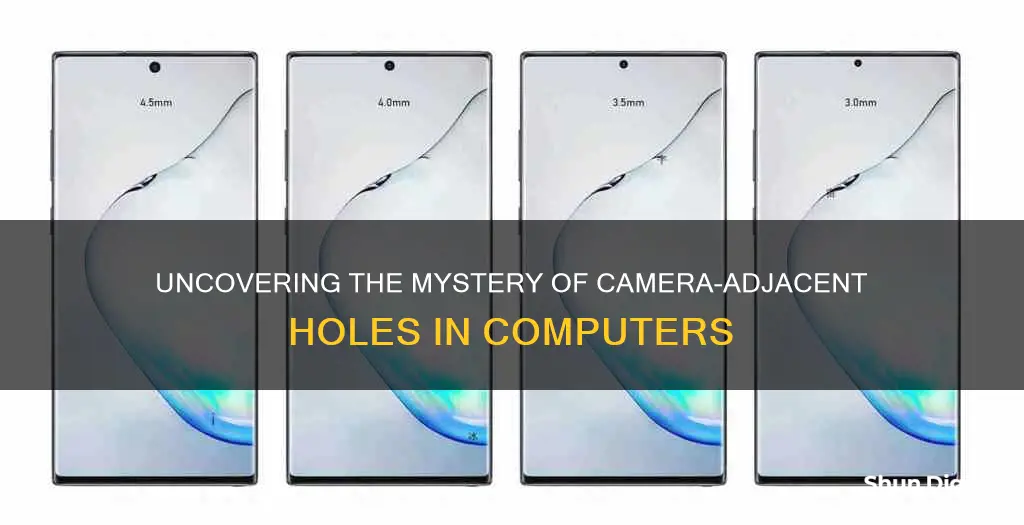
Many laptops have small holes next to the camera, which can be used for various purposes. In some cases, these holes may be microphone openings, designed to pick up audio from people sitting in front of the laptop. In other cases, they could be infrared sensors used for facial recognition, such as Windows Hello. Additionally, one of the holes might be a small light that indicates when the camera is in use.
| Characteristics | Values |
|---|---|
| Purpose | Microphone, Face Scanner, Ambient Light Sensor |
What You'll Learn

Microphone holes
The small holes next to a computer camera are often microphone holes. Microphones on laptops are usually very small and can be easily mistaken for dust particles. These holes are designed to pick up audio, and their placement near the webcam ensures optimal sound quality during video calls or voice recordings.
In the case of the HP EliteBook 830 G5 laptop, for example, there are two sets of microphone holes. One set is described as "world-facing" or "forward-facing," designed to pick up audio from people sitting in front of the laptop. The other set is located inside the lid, facing the user, and is meant to capture the user's voice more effectively.
The number and arrangement of microphone holes can vary across different laptop models. For instance, the Toshiba Chromebook has a dual-array microphone setup near the webcam, with three dots in total: two microphone holes and one light indicator for the webcam.
It's important to note that while these holes are typically associated with microphones, there may be slight variations in their functionality depending on the specific laptop model and manufacturer.
To summarize, the small holes next to a computer camera are typically microphone holes, and their purpose is to capture audio. The number and arrangement of these holes can vary, and they work in conjunction with the webcam to provide a clear and audible sound during various computer activities.
Surveillance Camera Setup: A Step-by-Step Guide to Wiring
You may want to see also

Face scanner
The holes next to a computer camera often have multiple functions. One of the holes may be a light indicator, showing whether the camera is on or not. There may also be a microphone, and in some cases, a face scanner.
In the context of a computer, a face scanner can be used for secure login and authentication, as seen with Windows Hello. This feature allows users to log in to their device using their face, providing a convenient and secure alternative to passwords or PINs. The face scanner uses infrared light to capture an image of the user's face and create a unique facial signature, which is then compared to the enrolled user's data to verify their identity.
In addition to security, face scanners can also enhance the user experience by providing personalised settings. For example, in dentistry, 3D face scanners like the MetiSmile can capture facial information to create 3D models, aiding in clinical diagnosis and treatment planning. This technology can simulate facial transformations before orthodontic treatments, providing a more realistic and vivid experience for patients.
Florida's Camera Tickets: Are They Legal?
You may want to see also

IR illuminator
In addition to enhancing night vision, IR illuminators can also serve other purposes. For example, in laptops, IR illuminators may be used in conjunction with infrared cameras for facial recognition features such as Windows Hello.
When choosing an IR illuminator, it is important to consider factors such as the illumination range, angle of coverage, power requirements, and compatibility with your camera system.
Exploring Camera Tickets: Are They Still Used Today?
You may want to see also

Ambient light sensor
An ambient light sensor is a tiny piece of hardware that detects the amount of light in its vicinity. It has been around for years and is present in most modern devices. It allows your device to dynamically adjust the brightness of your display according to the light around you, creating a more consistent viewing experience.
The ambient light sensor detects the light shining on the device and automatically adjusts the backlighting for optimal viewing. For example, in a brightly lit office, the sensor increases the brightness to make the screen easier to read. On the other hand, when working late at night with minimal lighting, the sensor detects the low ambient light and dims the screen.
You can usually find the ambient light sensor setting on your device by going into the Settings app. On a Windows device, click on "System" or "Brightness and Color." If you see an option to change brightness automatically when lighting changes, then your device has an ambient light sensor. On a Samsung device with Windows 8/8.1, you can swipe your finger from the right edge of the display to the left to open the Charms menu, then click on "Settings" and follow the steps outlined previously.
While the ambient light sensor is a convenient feature for many, some users may prefer manual control over the screen brightness. The good news is that you can turn the ambient light sensor on and off. For example, on a Dell laptop, you can press the "Fn" key and the left arrow on your keyboard to toggle the sensor on or off. Pressing the "Fn" key and the up or down arrow keys will disable the sensor and allow you to manually adjust the brightness.
Speeding Tickets from Cameras: Admissible Court Evidence?
You may want to see also

Camera light indicator
The camera light indicator is a privacy safeguard that is supposed to let you know when your camera is recording. However, research has shown that few computer users notice the light, and even fewer realise that the camera is always recording when the light is on. This makes people more vulnerable to webcam spying.
The webcam light is a type of privacy indicator, which is a notification that a user’s data is being collected in some way. Other privacy indicators include the green Secure Socket Layer lock in the website address bar that indicates a secure connection or the pop-up on a smartphone asking for consent to share your location with an app.
The light is usually hardwired to turn on when the camera starts recording. However, whether or not the light switches on really comes down to the device’s firmware. And unfortunately, firmware can be overridden. Researchers proved it back in 2013 when they managed to hack a MacBook camera without the LED light ever coming on.
If you are concerned about webcam spying, there are a few things you can do to protect yourself:
- Pay attention to your device’s camera light indicator. If the light is on, it means your camera is active.
- Use a reliable antivirus program to detect and bust malicious threats.
- Be cautious of phishing attempts, such as emails from unknown senders with suspicious links or attachments.
- Cover your webcam with tape or a sliding cover when not in use.
- Be mindful of your surroundings and avoid doing sensitive tasks in front of your computer when possible.
Yashica Cameras: Still in Production or a Thing of Past?
You may want to see also
Frequently asked questions
The holes next to your computer camera could be microphone holes.
The microphone holes are used to pick up audio from people sitting in front of the computer.
Yes, one of the holes might be a light that indicates whether the camera is on or off.
One of the holes might be an ambient light sensor that adjusts the screen brightness based on the surrounding light levels.







